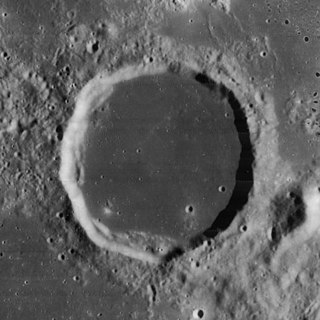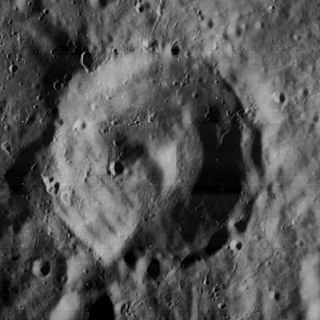
Birt is a lunar impact crater located in the eastern half of the Mare Nubium and west of the Rupes Recta. It was named after British selenographer William R. Birt.

Brayley is a lunar impact crater located in the southwest part of the Mare Imbrium. It was named after British geographer Edward W. Brayley in 1935. It has a circular rim and a low rise in the center. There are no notable craters overlapping the rim or interior. The sinuous rille Rima Brayley passes to the north of Brayley.

Cauchy is a small lunar impact crater on the eastern Mare Tranquillitatis. It was named after French mathematician Augustin-Louis Cauchy. It is circular and symmetric, with a small interior floor at the midpoint of the sloping inner walls. Due to the high albedo of this bowl-shaped formation, it is particularly prominent at full Moon.

Fauth is a small double-crater located at the edge of the rough southern ramparts of the prominent ray crater Copernicus on the Moon. It lies in the Mare Insularum, to the northeast of the crater Reinhold. The crater is named after German selenographer Philipp Johann Heinrich Fauth.

Gay-Lussac is a lunar impact crater located to the north of the prominent crater Copernicus, in the southern foothills of the Montes Carpatus range. The rim of the crater is slightly distorted, although generally circular. The inner floor is flat but rough, with no central peak. There are a pair of small craterlet depressions in the middle instead of a central peak. The associated crater Gay-Lussac A is nearly joined to the southeast rim.

Cleomedes is a prominent lunar impact crater located in the northeast part of the visible Moon, to the north of Mare Crisium. It was named after Greek astronomer Cleomedes. It is surrounded by rough ground with multiple crater impacts. The irregular crater Tralles intrudes into the northwest rim. To the east is Delmotte. North of Cleomedes is a triple-crater formation with Burckhardt occupying the center.

Ariadaeus is a small, bowl-shaped lunar impact crater on the western shores of Mare Tranquillitatis. It lies to the north of the crater Dionysius, and to the west-southwest of Arago. The crater is joined along the northeast rim by the slightly smaller Ariadaeus A, and the two form a double-crater. Its diameter is 10.4 km.

Delisle is a small lunar impact crater in the western part of the Mare Imbrium. It was named after French astronomer Joseph-Nicolas Delisle. It lies to the north of the crater Diophantus, and just to the northwest of the ridge designated Mons Delisle. Between Delisle and Diophantus is a sinuous rille named Rima Diophantus, with a diameter of 150 km. To the northeast is another rille designated Rima Delisle, named after this crater.

Flammarion is a lunar impact crater on the south edge of Sinus Medii. Its diameter is 76 km. It is named after the French astronomer Camille Flammarion. It is located between the crater Mösting to the northwest and Herschel to the southeast. The bowl-shaped Mösting A intersects the western rim of Flammarion.

Hortensius is a small, bowl-shaped lunar impact crater that is located in the northern part of the Mare Insularum. It was named after 17th century Dutch astronomer Martin van den Hove.

Silberschlag is a small, circular Impact crater in the central portion of the Moon. It was named after German astronomer Johann Silberschlag. It lies between the craters Agrippa to the southwest and Julius Caesar to the northeast. Silberschlag is bowl-shaped and is joined at the northern rim by a small ridge.

Boss is a lunar impact crater that is located along the northeast rim of the Moon's near side. Due to its location, the crater is viewed from the side by observers on the Earth, and its visibility is subject to libration effects.

Baily is the remnant of a lunar impact crater on the boundary between Mare Frigoris to the north and Lacus Mortis to the south. The crater interior has been flooded by lava in the past, and only the northern half of the crater rim remains relatively intact. There is an outward bulge in the northeastern rim, possibly the remnant of another crater formation that once overlapped Baily. The crater interior is flat and relatively featureless, with no impacts of significance. The surviving outer rim reaches a maximum elevation of about 0.5 km.

Billy is a lunar impact crater that is located at the southern fringes of the Oceanus Procellarum, in the western hemisphere of the Moon. It was named after French mathematician Jacques de Billy. It lies to the southeast of the similar-sized crater Hansteen, and west-southwest of the flooded Letronne.

Calippus is a small lunar impact crater that is located on the eastern edge of the rugged Montes Caucasus mountain range in the northern part of the Moon. It was named after Greek astronomer Callippus of Cyzicus. It lies to the southwest of the crater remnant Alexander, to the northwest of the Mare Serenitatis.

Ball is a lunar impact crater that is located in the rugged southern highlands of the Moon. It was named after British astronomer William Ball. The formation is circular and symmetrical, and has received little significant wear. The interior is rough-surfaced, curving downward toward the relatively wide central peak at the midpoint.

Conon is a small but prominent lunar impact crater that lies in the eastern foothills of the Montes Apenninus mountain range. The crater is named for the Greek astronomer Conon of Samos. Just to the west of Conon is the long mountainous ridge Mons Bradley. The nearest craters possessing an eponym are Galen, about 70 kilometres (43 mi) to the east, and Aratus, about the same distance to the northeast.

Yangelʹ is a small lunar impact crater that is located in the irregular terrain to the north of the Mare Vaporum. Its diameter is 8 km. It was named after Soviet rocketry scientist Mikhail Kuzmich Yangelʹ in 1973. This crater was formerly designated Manilius F.

G. Bond is a small lunar impact crater to the south of the Lacus Somniorum, a small lunar mare in the northeast part of the Moon's near side. It was named after the American astronomer George Phillips Bond. It lies to the east of the larger crater Posidonius, and to the south of the flooded crater remnant Hall. The crater is situated in a rugged section of terrain to the northwest of the Montes Taurus mountain region.

Mons Bradley is a lunar mountain massif in the Montes Apenninus range, along the eastern edge of the Mare Imbrium. It is located to the west of the crater Conon. To the west of this peak is the Rima Bradley rille.






















